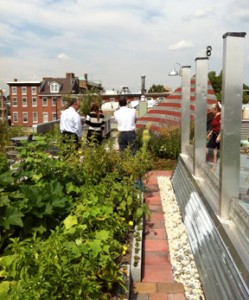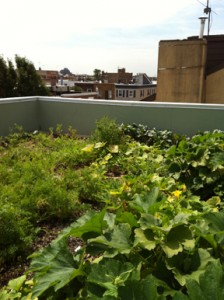Roof Top Farm Profitability?
After my recent post via Facebook was removed by Green Roofs for Healthy Cities I’m feeling even more enthusiastic to re write a more formal comment in response to an article printed in the Living Architect Monitor. “On the Roof with Urban Agriculture Rock Stars” depicting what I consider social entrepreneurs with big ambition and constricted sources and means of application. There is no argument our food supplies are pressured to increase quantity only to sacrifice quality, we are failing and statistics are evident. Our population is obese, malnourished and some populations lack the ability to access quality food and when they do there is a premium cost. Don’t be confused with our industrial ability to grow food, because we can in fact grow more food controversy it lacks the nutrition and quality we would expect from organic or traditionally, pre WWII, grown produce. There are too many references to list for this commentary and with little effort a simple search engine can provide you the resources that support the lack of quality food with a click of a mouse. The article interviews some of the social heroes in our world, their efforts to provide quality and a secure source of food is a gallant but it is not profitable. That’s right I said it, “It is NOT profitable”. I sympathize with two sides of all of their efforts. On one hand they are social giants who are working hard to provide society a valued service, fresh local food and maybe a living wage job. Reverse the role and they are in a business sacrificing themselves selflessly as a “Social Entrepreneur”. Wikipedia defines a social entrepreneur as “the attempt to draw upon business techniques to find solutions to social problems”. In my experience the social entrepreneur of this caliper and magnitude is someone of passion and caring yet sacrifices their own well-being for that of others. This sacrifice also includes being not being profitable or just getting by! I know countless stories of friends and colleagues who are continuously funding their own nonprofit, CSA, urban farm for the love and betterment of others. What they don’t realize is they need to fund themselves before they can help others.
After reading the article it was very clear there was a common thread. Roof top farms and urban agriculture is not profitable! I said it again, NOT profitable. This is also a theme that was present at an Urban Farming roundtable I was invited to via New York State Senator Kirsten Gilibrand. Attendees wanted to know how they can make money as urban farmers. How can we create jobs? How can we have access to fresh food without paying or charging a premium? The interview questions were straight forward but all dodged the main point of the very first question. “Is there economic value to edible roofs and walls”? First let me state not one addressed edible walls or vertical farming. With all respect it is only because those interviewed have no experience of the matter and the question should have been directed to me personally.
Will (Allen) claims the economic value, remember the question was specific to the economics of roof top farming and edible walls, is based on one’s experience and how much money you can make per square foot. Ben (Flanner, Brooklyn Grange) feels eventually there will be a positive return on capital but did not state when he would expect that return. It was apparent the sale of produce was not enough the roof farm was subject to having to host weddings, yoga classes, educational workshops, dinners, lunches and office retreats. Ron (Finely) feels there is a value because you grow your own food “so you’re saving”, but, what is the labor vs return trade off and could you feed yourself 12 months of the year? Is there an emotional or personal value and is it really an economic upside? John (Stoddard) finds value in the environment by reducing storm water and energy. Betsy (Mason) also shares the same perspective both avoid the capital value and focused on the environmental benefits, which are well documented in the green roof industry. Mohamed (Hage) mentions jobs and the relationship to the consumer but didn’t elaborate how to afford those jobs. Will also has 40 different income streams from the farm to keep it running, according to him, “It’s pretty tight each month”. Ben brings in educational tours that contribute to the revenue and John is “Still working on” making their work economically self-sustaining.
Since they won’t say it, I will, again. Roof top farming and urban agriculture is not profitable and for a few reasons. They are not making ends meet and the budgets balance by growing and selling produce 8 months a year, locally, at a premium, competing with other large scale farmers for the same consumer during the same season, there are your unknown environmental variables and inconsistent yields, it is a model that cannot compete with mass produced farming.
How can urban food production become sustainable and profitable? Will feels training more farmers, but why? If the model cannot providing a living wage attracting more farmers is not an answer. Farming is a noble profession, like being a teacher. Personally as a former teacher we are underpaid and over worked overwhelmed with standardized testing but someone has to do it and it is usually those who teach simply for the love of education not the money. Using renewable energy, replenishing soil, partnerships with university and corporations won’t make your produce more valuable to the consumer. Ben is getting close, “Use our space to the fullest”. I personally love Ron Finley’s expression of teaching people how to feed themselves but we are talking about “Profitable Urban, Rooftop and Vertical Farms”. Ron is the epitome of a selfless social entrepreneur.
There is a clear frustration in all the interviews, there is simply not enough money being made to support the effort. These farms, except for Mohamed’s roof top hydroponic greenhouses, operate during the same time of the year local produce is abundant and at a lower price point. It is simple supply and demand and having produce available for a short period of time reduces the single most important asset, the ability to earn off season and not compete with big box farms or distributing importers of produce during the same seasons.
Let’s leave the urban farmers on the ground out of the conversation for now and discuss the roof top farm, both hydroponic and media in addition to the benefit or threat they may pose to the community. The obvious benefit of a roof top farm would be to grow food, its purpose for profit or quantity is clearly subject to the previous comments on profitability but the article avoids the potential hazards by highlighting secondary benefits included protecting the waterproofing, storm water retention, and sound and pollution mitigation. More green-roof benefits can be found at www.greenroofs.com and while you are there visit my articles as the “Green Wall Editor”!
Typical green roof installations include a layer of engineered media which is derived from a considerably high ratios of aggregate. Ratios may be between 80 and 85 percent lightweight aggregate and lower concentrations of organic material for extensive vegetative roofs. Typically this media is excellent at allowing water to drain and lacks the ability to hold much need nutrients. Typically the inexperienced green roof maintenance technician will notice the green roof starting to break down, plants are stressed, dyeing, there is weed infestation usually at the two year mark leading them to believe the roof lacks fertilizer. After a fertilizer application 98% of the fertilizer will run off the roof! The green roof just became an environmental problem as the fertilizer just washed itself into the storm water system. This is why you will see green roofs starting to fail at the 2 year mark. Roof top farms are not your typical green roof. Roof top farms require a much higher level of organic matter which will consistently need to be replaced. If organic growing means are applied compost will be the main source of nutrition. It will leech the nutrients into the media making them available to the existing crops. Over time the media will require more and more compost to be replaced, it is a balancing act between too much weight and eventually exceeding the roof load and the need to add nutrition. The ethical question is, are these roof top farms using compost and fertilizer? And where is the fertilizer ending up? That’s right, we know more than likely into the storm water runoff.
This brings me to the use of hydroponics on the roof and in general. Make no mistake I am outspoken, I don’t abide
by social media rules, I’m not politically correct and I represent our company and our values that food should not be grown hydroponically! There is a whisper in the industry that no one else will expose. Hydroponic chemicals are dangerous and there is controversy about organic hydroponics because the derivatives of organic fertilizer are not water soluble, so how can it possibly be organic? The popularity of hydroponic growing has provided larger scale farms that will also become part of the environmental issue. Traditional agriculture has destroyed the soil since the introduction of synthetic fertilizer after WWII. Killing microbes and upsetting the natural balance of the environment by never allowing the soil time to heal. The result is more fertilizer for more crops leads to more run off and soil that does not have the ability to grow food without synthetic applications.
Hydroponics lack soil while the plants are fed by a bath of chemically infused water. The water lacks the natural processes provided by microbial relationships and humic acid providing a superior taste and nutritional value. The plants are pretty much force fed. Pending on the facility there are two types of hydroponic systems, a closed loop system or drain to waste. All hydroponic methods require water to be removed from the system for cleaning or to replace the nutrient solution. Rhetorically speaking where do you think that chemically infused water is going? No matter what method the water in a hydroponic reservoir, closed loop, requires changing every 10-14 days! The water needs to be dumped or drained. On a smaller scale I can attest that water is being poured down a common drain! For more on my perspective of Hydroponics and why it should not be allowed, especially in schools unless under a curriculum of a chemistry teacher visit one off my recent articles “Hydroponic Growing Systems….A threat to Students”. The MSDS sheets from the nutrient solution manufactures alone should tell you to avoid hydroponics.
Since 2004 Green Living Technologies International LLC (GLTi) has been developing vertical farming solutions that are a closed sustainable system from cradle to grave use of all resources with environmental controls to calculate maximum yields of virtually any edible or medicinal crop from 5 to 10 times the traditional yields of horizontal configurations at a 12’ height without stacking. Our technology is limited simply by the height of the facility, as the height increases so do the yields. It is our extended R&D that has cracked the code for vertical farms using organic means and traditional farming techniques to produce the quantity and quality of produce that is currently unavailable. The GLTi Vertical Farms are calculated to have virtually zero waste water, use our proprietary bioSoil (100% organic) and are scalable, cash positive and profitable within 90 days of the initial build out with a return on investment in less than 15 months. The initial 4000 square foot model allows for 15 full time employees extending living wages, paid internships, education programs for learners and at risk populations at no additional cost. We do not rely on external streams of income to be profitable. GLTi is the first and proven leader in “From Wall to Table” and our exchange program brings “Living Produce” directly into the restaurant! Your food is still growing seconds before it is served! You can’t get fresher or more organic than that!
The underlying issues with roof top and urban agriculture include the environmental variables, methods and means in which produce is grown and the seasonal competition of larger commercial growers. You can’t feed the world on leafy greens! Competing with large scale farmers and low cost seasonal crops it is not fiscally feasible to sustain a consistent and planned return on capital. We find our own roof top farm in Philadelphia is ideal for self-use. A smaller location of 600 square feet can produce a couple thousand pounds of food complementing Ron Finley’s perspective of growing your own you have the satisfaction of knowing where your food came from and with some sweat equity result in some nice yields. If you’re serious about commercial scale agriculture and want to make a profit you have to grow year round producing crops that are off season not to compete with local growers and have a consistent customer. We secure buyers long before a build out. Control your environment and do it organic!
About the Author
George Irwin is the founder and President of Green Living Technologies International LLC (GLTi), a privately held company that manufactures Green Living Walls, Green Living Roofs. It is also the global pioneer in vertical agriculture with a focus on education & training. A published author and featured “Green Wall Editor”, George is also a leading resource and authority for green wall and roof technologies around the world. TIME, Fortune & Profit magazine, CNN, NBC, ABC, National Geographic, Newsweek, the Los Angeles Times and the New York Times are among the major media to feature stories about George and GLTi.
Prior to founding GLTi, George was a landscape contractor for over two decades. He holds a degree in education and maintains his passion for out-of-the-box learning, combining his love for the environment and zest for learning into a growing global business. George personally oversees all green wall and roof education, integrating his state-of-the-art technology and ideas into a continuously evolving educational and training curriculum. Annually, he teaches hundreds of new green technology experts in green roof manufacturing, installation, growth, and maintenance. His efforts have earned him recognition as one of the educational partners for the New York City Department of Education and an association with multiple higher education facilities and universities, resulting in the development of a dedicated degree track in “Green Tech” and STEM (Science Technology Engineering and Math) education at the middle and secondary school levels. George is the de facto leader in Green Education with anticipated long-term commitments from leading colleges and graduate programs coast-to-coast.
His vision extends well beyond achieving his own entrepreneurial aspirations: His mission is to help create sustainable solutions to the challenges of food insecurity and the dearth of job opportunities for at-risk youth in America’s inner cities. His technology is quickly replacing complex mechanical systems and hydroponics with simple growing techniques that can be replicated on any scale. Research studies have been underway to measurably prove just how economically viable and productive his state-of-the-art systems are for maximizing the growth of food year-round.
George Irwin may be contacted by e-mail at george@agreenroof.com for speaking engagements, classes, and keynotes. Click link for Authors bio.









